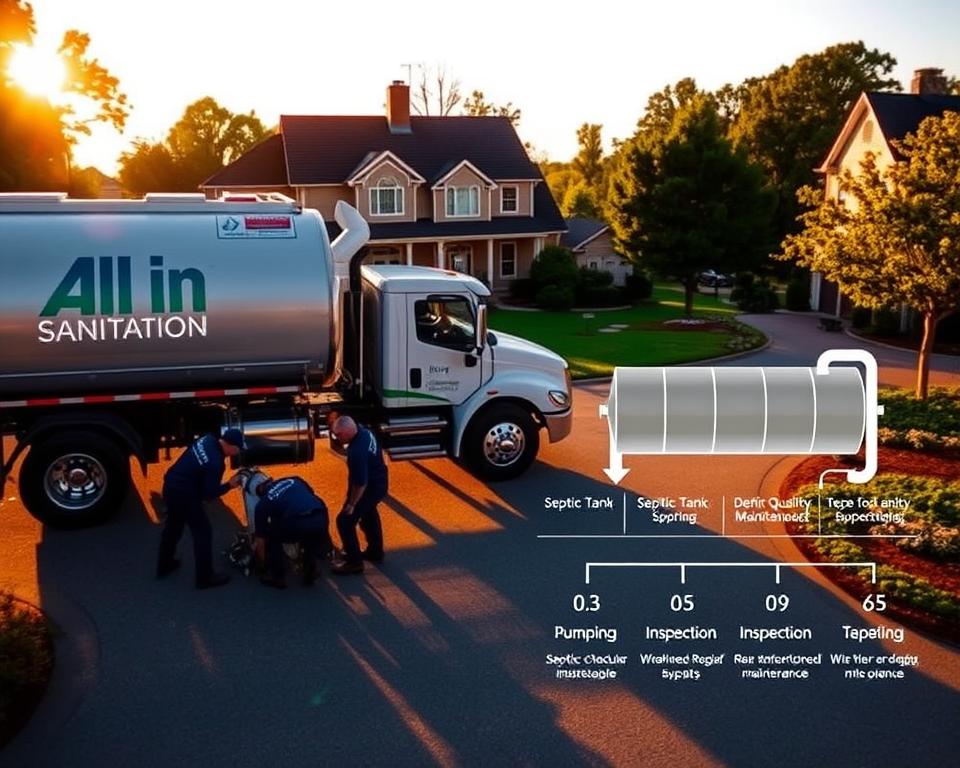Your Expense Guide for Septic Tank Pumping
Have you paused to consider about the actual cost of up‑keeping your septic system in good order, or whether you’re paying more than necessary? It’s critical for property owners to grasp the particulars of septic tank pumping prices. Generally, the cost is roughly $420, yet it can fluctuate significantly. This spread comes from factors like your tank’s size and geographic area – septic tank inspection cost.
Routine maintenance of your septic tank avoids hefty fixes, underscoring the value of understanding service costs. This article will dive into septic tank service pricing thoroughly. This will help you plan cost‑effectively for your system’s maintenance.
Significant Points
- Average septic tank pumping comes to about $420 USD.
- Prices can fall between $290 USD and $560 USD subject to various conditions.
- Regular servicing prevents larger repairs in the future.
- Most households call for pumping every 3 to 5 years.
- Family size and consumption can influence pumping schedule.
Recognizing the Importance of Septic Tank Pumping
Septic tank pumping is crucial for a efficient wastewater system. It removes solids that, if left unchecked, cause backups. Timely pumping also avoids bad smells but also sidesteps high repair costs.
Neglecting septic tank maintenance can compromise our extensive reliance on these systems. Thankfully, cost‑effective services minimize the risk of system failure. Regular upkeep extends your septic system’s life, guaranteeing trouble‑free operation.
Pricing for septic tank upkeep teaches the value of forward‑thinking care. Maintenance detects problems before they escalate, heading off serious damage and hefty repair bills. Regular pumping is a smart move for homeowners to protect their property and gain peace of mind.
Average Costs for Septic Tank Pumping
Septic tank pumping generally comes between $250 USD and $600 in cost. Most times, homeowners will spend about $400 for this essential service. Cost swings are driven by factors like capacity, where you live, and how often service is done. Common tanks, around 1,000 gallons, usually cost between $225 and $400 USD.
Homeowners should realize the importance of allocating funds every three to five years for septic tank cleaning. This regular care relies on the usage level and size. It helps avert more serious, costlier issues later, demonstrating to be both labor and budget friendly.

Elements Shaping Septic Tank Pumping Prices
Several factors are important in establishing the cost of septic tank pumping. Understanding these details helps homeowners to budget for these essential services wisely.
The volume is significant immensely. Bigger tanks require more effort and time to empty, which translates into higher fees. The accessibility to your tank also significantly impacts the price. Tanks set far underground or in hard‑to‑reach locations necessitate more time and special tools from technicians, thus raising the labor costs.
Costs can swing widely based on where you live. This is due to differences in local labor rates and dumping charges. For example, some areas impose higher charges for removing waste, impacting the total service cost. Moreover, tanks with significant solid waste accumulation also attract additional fees—anywhere from $100 to $300. Plus, the more frequently a tank requires pumping—due to higher system load—the higher the ongoing expenses.
Septic Tank Size and Its Influence on Cost
The size of your septic tank strongly affects the cost of its upkeep. Compact tanks, for example, those that can hold 750 gallons, typically have lower pumping costs, generally ranging from $175 to $300. On the other hand, higher‑capacity tanks, capable of holding up to one thousand seven hundred fifty gallons, may incur charges between $400 USD and $700. The majority of single‑family residences have tanks that hold between 1,000 to twelve‑fifty gallons, delivering a blend between size and efficiency.
Homes with compact systems or many residents often require more frequent pumping services, which improves the overall expense. It’s vital to conduct regular septic tank inspections in these situations. This makes sure the tank does not overflow or malfunction, which helps avoid additional damages. By understanding the relationship between tank size and service fees, homeowners can take well‑informed choices regarding their septic systems and their upkeep demands.
Location‑Based Changes in Septic Tank Pumping Costs
Septic tank pumping costs can differ greatly based on area. In urban areas, the expenses are frequently higher due to local septic services facing increased overhead. For example, Minneapolis, MN residents may spend between $180 and $280, while those in Portland, OR could see prices from $440 to $750.
The reasons behind these disparities are varied. They include regional expenses, demand for septic specialists, and regional regulations. In places where septic services are limited, homeowners might spend extra due to the lack of options. Moreover, tough regulations in some regions can push up the need for higher compliance fees, influencing the cost of services.
Knowing about these geographic cost variances is important for homeowners. It enables them to forecast their septic maintenance spending more precisely. By understanding local pricing, they can seek quotes from specialists prudently, maintaining their septic system properly without breaking the bank.
Extra Expenses to Consider with Septic Tank Pumping
Homeowners often forget about various additional maintenance costs linked to septic tank pumping. The base cost pays for just the essential service, leaving out other potential expenses. Knowing these can aid in preparing a comprehensive budget.
Video line checks, for instance, range between $250 USD to $500. They offer a no‑dig look into the system’s condition. Additionally, filter rinsing, which if ignored can create system failures, represents another cost.
The range for repairs can be broad, from $100 to $4,000, depending on the specific issues. This spread highlights the need of factoring in additional maintenance costs for future budgeting.
Budgeting for Septic Tank Maintenance
When planning for septic tank upkeep, it’s vital to take a all‑inclusive view. This incorporates multiple critical elements. Owing to variable factors, the cost of maintenance can shift considerably. Therefore, effective financial planning is essential.
To make sure your system functions smoothly and to avoid unexpected bills, keep these intervals and services in mind:
- Routine pumping: This service is typically required every 3–5 years.
- Inspections: Budget for around $250 to $1,180 for inspections every three years.
- Potential repairs: Reserve a fund for unexpected fixes, which can occur unexpectedly.
Setting up a recurring maintenance calendar with a reliable septic service is essential. By forecasting these expenses, homeowners can sidestep the steep costs tied to neglect. This approach secures the durability and efficiency of their septic systems.
Common Signs That Your Septic Tank Needs Pumping
Keeping watch to your septic system’s condition is crucial. Spot the first signs that suggest your septic tank is due for pumping. Doing so can avoid serious damage and lower repair costs.
- Slow drains: Water taking longer to drain in sinks, tubs, or toilets could indicate your septic tank is overflowing.
- Unpleasant odors: Bad smells coming from the septic tank or in your yard are often clear indicators of a problem.
- Gurgling sounds: Unusual gurgling from your plumbing might suggest air is trapped because of a blockage.
- Wet spots: Standing water or greener grass sections near the drain field point to waste seepage from the tank.
- Dark green grass: Grass that is deeper green and seems healthier around the drain field may show leakage of nutrients, suggesting an issue.
Regular checks by septic system experts can maintain your tank is in healthy condition. Using seasoned septic technicians for maintenance stops these issues, supporting your system’s longevity.
Advantages of Routine Septic Tank Inspections
Scheduled inspections are central to keeping your septic system in excellent order. They spot potential problems before they turn into major repairs. By bringing in professionals for these checks, every part of your system gets a thorough assessment.
The process looks at multiple parts of your system, including waste levels and the drain field’s state. It ensures that critical parts, like baffles, function as they should. Finding issues sooner helps prevent hazardous overflows and shields the environment, aiding both your home and the wider community.
Having your septic tank checked every three years can reduce a lot of money. It stops bigger issues from developing due to neglect. This not only saves on repair costs but also gives your peace of mind.
| Inspection Aspect | Importance |
|---|---|
| Waste Level Assessment | Prevents overflow and backups |
| Drain Field Evaluation | Identifies saturation and function |
| Component Functionality Check | Ensures proper system operation |
| Early Problem Detection | Saves on repair costs |
Ways to Cut Costs on Septic Tank Pumping Prices
Homeowners aiming to lower septic tank pumping costs have multiple strategic options. Setting up group services with neighbors is one effective method. This involves coordinating with others nearby to request services together, potentially landing group discounts. It’s a way to boost community bonds while trimming expenses more economically.
Another practical approach is to join maintenance plans with septic service providers. These plans often offer lower fees for regular check‑ups and pumpings, ensuring septic systems operating properly at a lower cost. Homeowners are urged to ask about these plans when contacting service companies.
Keeping the septic tank accessible can also lower pumping expenses. Simple accessibility means there’s no need for extra labor charges. It’s important to keep the area around the tank free from obstructions, permitting straightforward servicing.
Adopting certain habits helps in extending the time between pumpings as well. Lowering water usage and minimizing garbage disposal use are important practices. These actions can significantly improve septic system health, reducing the need for regular maintenance. By following these habits, homeowners can successfully trim their septic tank pumping costs, safeguarding their wallets and systems.
Conclusion
Ensuring routine septic tank pumping is key for homeowners who want to keep their waste management system sound and in top shape. Knowing about the costs involved permits effective budgeting. This way, you can secure cost‑effective septic services without compromising your system’s performance.
Taking a forward‑thinking approach to maintenance is extremely beneficial. By watching for clues that indicate the need for pumping, you can dodge hefty repairs and lengthen your system’s lifespan. Such actions not only boost your home’s functionality but also provide you peace of mind.
Ultimately, keeping up with regular inspections and timely septic tank pumping is essential for effective home maintenance. By prioritizing proper planning and choosing affordable septic service, you’ll secure your septic system remains working and reliable for many years.

